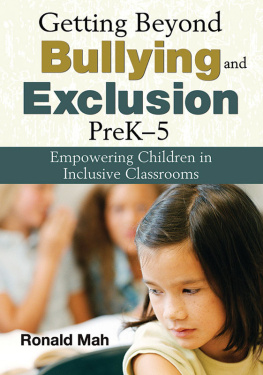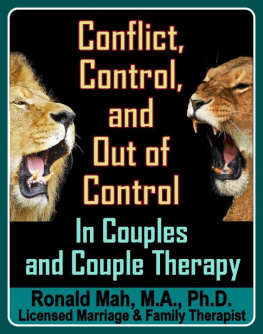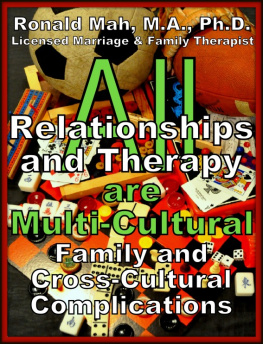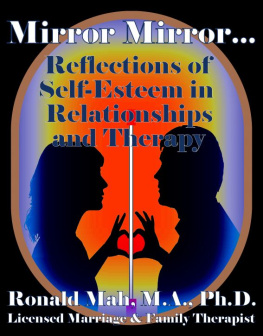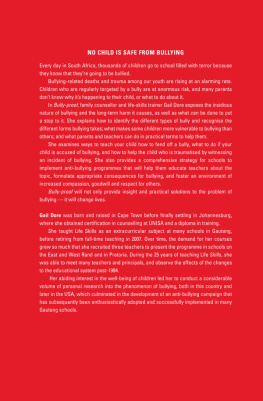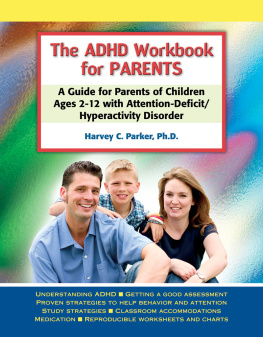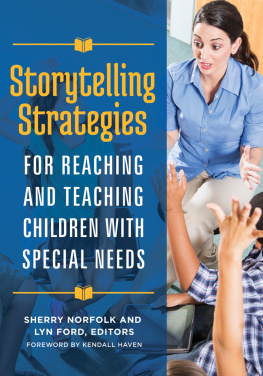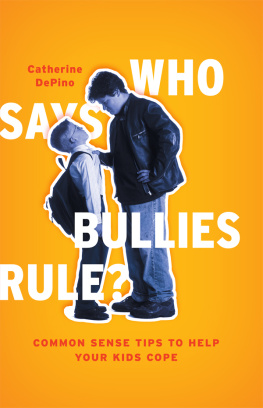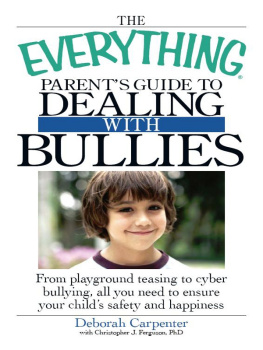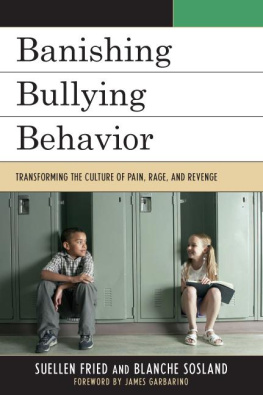Getting Beyond
Bullying and
Exclusion
PreK5
Empowering Children in
Inclusive Classrooms
Ronald Mah

Getting Beyond
Bullying and
Exclusion
PreK5
Copyright 2009 by Corwin
First Skyhorse Publishing edition 2013
All Rights Reserved. No part of this book may be reproduced in any manner without the express written consent of the publisher, except in the case of brief excerpts in critical reviews or articles. All inquiries should be addressed to Skyhorse Publishing, 307 West 36th Street, 11th Floor, New York, NY 10018.
Skyhorse Publishing books may be purchased in bulk at special discounts for sales promotion, corporate gifts, fund-raising, or educational purposes. Special editions can also be created to specifications. For details, contact the Special Sales Department, Skyhorse Publishing, 307 West 36th Street, 11th Floor, New York, NY 10018 or info@skyhorsepublishing.com.
Skyhorse and Skyhorse Publishing are registered trademarks of Skyhorse Publishing, Inc., a Delaware corporation.
www.skyhorsepublishing.com
10 9 8 7 6 5 4 3 2 1
Library of Congress Cataloging-in-Publication Data is available on file.
ISBN: 978-1-62087-878-1
Printed in China
Contents
Acknowledgments
T hey said the kids hung out in Lindas classroom fifth period. We had just spent the weekend on a retreat organized by the Asian Student Union at Berkeley High School. My friends had been involved with the ASU, but the retreat was my first time participating. It was really cool, hanging out, sharing common interests and concerns. Now it was Monday back at school, and I remembered about hanging out at lunchtime in Lindas classroom. Linda Wing taught history and was the ASU sponsor.
I opened the door. A couple of dozen kidsAmerican-born, foreign-born, mostly Asian but some other kids tooeating lunch, talking, and laughing. Linda was sitting at her desk, in her mid-twenties, barely older than we were. I entered. She turned her face to me. And and she said, Hi Ronald. My heart leapt! She said, Hi, Ronald. I was so movedshe knew my name! Im important enough to remember my name? At a time in my life when I sometimes felt invisible, when I wasnt sure of who or what I was, she saw, knew, and acknowledged me. Hi, Ronald. That moment and through other experiences, Linda made me feel special and important. I graduated and then worked with her as a teachers aide, coming down from UC Berkeley almost every day. She helped so many other kids feel important during those years.
This book is dedicated to Linda and the other teachers that touch hearts and inspire the souls of kids. She inspired me to want to be like her. To help children feel important, like she made meusfeel important. To Linda and the teachers who touch our hearts, thanks for inspiring us to touch children at the times in their lives.
PUBLISHERS ACKNOWLEDGMENTS
We gratefully acknowledge the following peer reviewers for their editorial insight and guidance:
Karen Thomes, MEd/ECSE
Early Childhood Special Educator
Indian Island School
Indian Island, ME
Kathryn Underwood
Assistant Professor
School of Early Childhood Education
Ryerson University
Toronto, ON, Canada
About the Author

Ronald Mah, an educator and licensed marriage and family therapist, has worked in early childhood education for sixteen years. A credentialed elementary and secondary teacher, he is the author of Difficult Behavior in Early Childhood and The One-Minute Temper Tantrum Solution (2006 and 2008, Corwin). He wrote the Asian Pacific Islander Parent Education Support curriculum (Department of Human ServicesSan Francisco, 1996). Ronald has been featured in DVDs on child development and behavior (Fixed Earth Films) and has been involved in community and high school mental health clinics, and severe emotional disturbance, at-risk youth, welfare-to-work, and Head Start programs. As a graduate college instructor and board of directors member of the California Association of Marriage and Family Therapists and of the California Kindergarten Association, Ronald combines concepts, principles, and philosophy with practical techniques and guidelines for effective and productive results. Ronald has a psychotherapy practice in San Leandro, California, where he works with children, teens, adults, couples, and families.
Introduction
INCLUSION MEANS
Educational, social, economic, and political policy often collides with classroom reality. The inclusive classroom is a wonderful concept, but also a complex day-to-day challenge for teachers. Problematic behaviors already disrupting classroom communities, specifically exclusion and bullying, may intensify with greater inclusion of child diversity. The reality of modern education means children with a variety of learning and processing abilities and issues are in the general classroom, often with more and different academic and behavior problems. Principles of an inclusive classroom to address the challenges of learning and processing differences are similar to principles addressing socioeconomic diversities of race, ethnicity, religion, class, and family composition. Caring adults hope that children naturally accept each other, interacting with respect, appreciation, and kindness. Everyone wishes that were true, but if wishes simply just came true, then wed all have ponies! Reality as testified to by veteran teachers experiences, however, is that it is much more difficult. Children with challenges often experience misunderstanding and mistreatment by classmates, especially those with aggressive tendencies due to their own issues. When teachers are able to create respectful classroom communities, they become a joy in which to learn and teach. Children learn to relate to classmates in healthy and productive relationships predictive of fellow citizens in society.
This book will focus on children with one or more of four specific challenges: children with learning disabilities or differences (LD), children with attention deficit hyperactivity disorder (ADHD), children with Asperger syndrome (AS), and children with gifted abilities. The principles for supporting these children can be both derived from principles supporting all children and applied to children with various other challenges. Children with challenges are often in need of skilled and conceptually sound adult support. Diagnoses or labels represent higher or lower extremes on normal continuums of abilities or challenges. The more teachers become aware of the knowledge, skills, and wisdom acquired working in the typical classroom with a familiar spectrum of child diversity, the more they can apply that to working with and supporting children with specific challenges. Conversely, the more teachers become aware of their knowledge, skills, and wisdom acquired working with children with LD, ADHD, AS, and gifted abilities, the more they can apply that to working with and supporting a diversity of children in typical classrooms.
A functional definition of culture is that it consists of attitudes, values, beliefs, and behaviors that promote survival in a given context. The context of concern is a community with particular environmental requirements and challenges. The cultural adaptations in one context may or may not be cross-culturally effective in a new context. Specifically, moving from a supported environment such as home or a special education class to a general education classroom (or from one classroom to another), with new classmates or a new teacher will be cross-culturally challenging. Areas of survival include academic, social, emotional, psychological, and spiritual functioning. Children with LD, ADHD, AS, or gifted abilities may develop problematic attitudes, values, and beliefs for survival prior to and in the mainstream classroom. This may be expressed in sometimes unfathomable behaviors.

